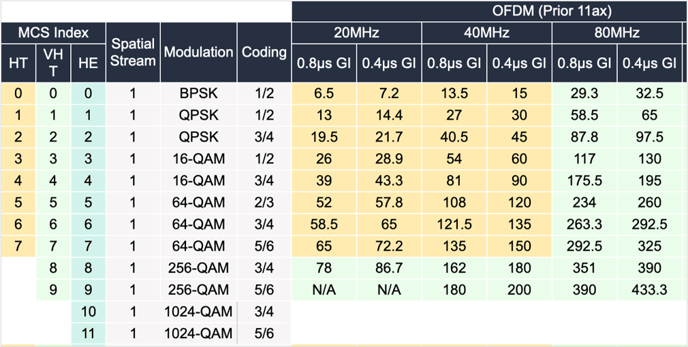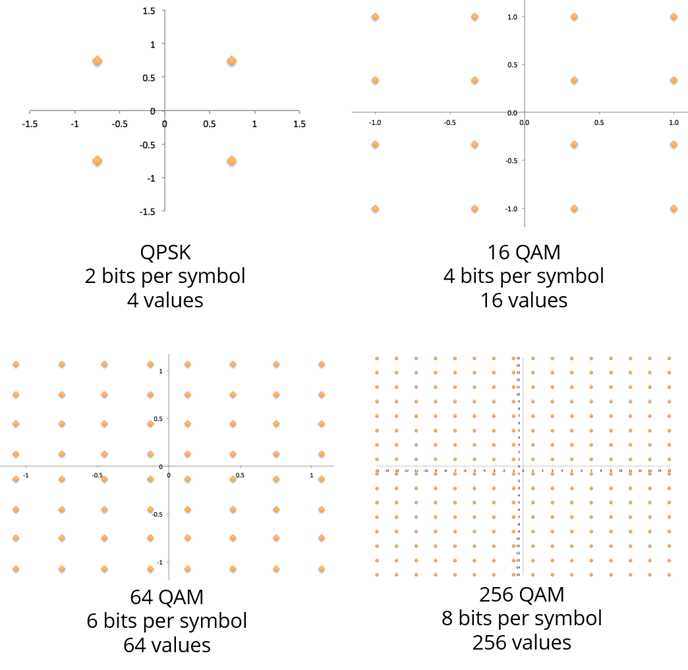Tells you if your Wi-Fi connection is the best it can be.
MCS Index
The Modulation Coding Scheme (MCS) index is an existing industry metric based on several parameters of a Wi-Fi connection between a client device and a wireless access point, including data rate, channel width, and the number of antennas or spatial streams in the device.
The MCS Index simplifies our understanding data rates. There are hundreds of different 802.11 data rates, so the MCS Index makes it easier to understand them. It describes the modulation type and coding rate used across a set of channel widths, guard intervals, and spatial streams.
As you can see along the left in the diagram below...
- 802.11n MCS values go up to 7
- 802.11ac MCS values, where QAM-256 was introduced, go up to 9
- With 802.11ax, where QAM-1024 was introduced, values go up to 11

Check out the full MCS table here.
Modulation
QAM (quadrature amplitude modulation) modulates amplitude and phase.
- Lower data rate modulation has larger differences between symbols (farther apart - see QPSK in diagram below). This results in greater protection from errors and a more robust Wi-Fi connection. It's like trying to hit the bullseye on a dartboard when standing right in front of it...easy.
- Higher data rate modulation has smaller differences between symbols (closer together - see 256-QAM in diagram below). This results in less protection from errors and a more fragile Wi-Fi connection. It's like trying to hit a bullseye on a dartboard from way across the room. Much harder!
Coding
Coding refers to the number of bits required to send "x" number of bits. For example, 3/4 means that 4 bits are used for every 3 data bits sent. The extra bits are for error correction.
Quality of Experience
It may seem like signal strength is a good value to judge connection quality, but unfortunately, signal strength is not measured consistently across Wi-Fi clients, and noise measurements from clients are very poor.
MCS reflects the real Wi-Fi performance a client is able to successfully achieve as it tries to use the highest possible data rate that channel conditions support.
A low MCS score (below 4) indicates that a client is facing significant challenges with its RF environment. Not only is the connection not optimal, but it indicates a serious underlying problem affecting the Wi-Fi experience.
Additionally, MCS abstracts away differing client capabilities like number of spatial streams, making it simpler to compare performance across devices.
MCS reflects the real performance the station has achieved and can be compared across devices and across PHY’s. However, the challenge is that the numbering scale is different depending on your wireless connection and your device’s capabilities.
The only difference between Wi-Fi clients you may see is that, depending on their generation of Wi-Fi and that of the AP they are connected to, they may have differing maximum values (7 for 802.11n, 9 for 802.11ac, and 11 for 802.11ax connections).
7MCS™ Wi-Fi Connection Score
Windows® does not expose MCS, so 7SIGNAL developed 7MCS which provides an MCS value for Windows 10 that may also be used for Mac's.
In addition, 7MCS adjusts MCS values from 802.11n so that they are no longer specific to a number of spatial streams. Also, 7MCS values can be compared across all Wi-Fi generations from 802.11n to 802.11ax. Think of it as a simple quality of experience rating scale, from 0 to 11, regardless of PHY or operating system.
| MCS | Modulation | Coding | Quality |
| 0 | BPSK | 1/2 | ⛔ |
| 1 | QPSK | 1/2 | ⛔ |
| 2 | QPSK | 3/4 | ⛔ |
| 3 | 16-QAM | 1/2 | ⚠️ |
| 4 | 16-QAM | 3/4 | ⚠️ |
| 5 | 64-QAM | 2/3 | ✅ |
| 6 | 64-QAM | 3/4 | ✅ |
| 7 | 64-QAM | 5/6 | ✅ |
| 8 | 256-QAM | 3/4 | ✅ |
| 9 | 256-QAM | 5/6 | ✅ |
| 10 | 1024-QAM | 3/4 | ✅ |
| 11 | 1024-QAM | 5/6 | ✅ |
| ⛔ | Critical Wi-Fi experience |
| ⚠️ | Degraded Wi-Fi experience |
| ✅ | Good Wi-Fi experience |
